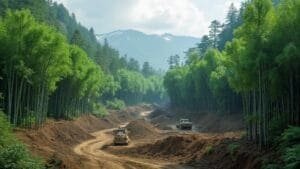Introduction
The red panda, an elusive and endangered species, is a critical part of Nepal’s biodiversity, inhabiting the forested regions of the Himalayan range
This article will explore the current population status of red pandas in Nepal, delving into recent data on their numbers, their habitat distribution, and the various threats they face
Additionally, we’ll examine the conservation efforts by both governmental and non-governmental organizations, focusing on how local communities contribute to these initiatives
Lastly, the article will highlight the pressing need for ongoing support to secure a future for red pandas in Nepal’s unique ecosystem
Red Panda Population Status in Nepal
Red pandas are listed as endangered by the International Union for Conservation of Nature (IUCN) due to their declining populations, and Nepal is one of the critical habitats where these animals can still be found in the wild
Nepal is home to an estimated 20-25% of the world’s red panda population, primarily found in the country’s eastern and central Himalayan forests
However, determining the exact population numbers of red pandas remains a challenge due to their elusive nature, remote habitats, and limited resources for extensive field research
Conservationists and researchers rely on periodic surveys and studies, but these estimates can vary due to factors like seasonal movement and changes in habitat conditions
Population Estimates and Trends
Recent surveys estimate that between 300 to 500 red pandas live in Nepal, though numbers vary across different regions and years. According to a 2019 survey conducted by the Red Panda Network and other partners, significant red panda populations were identified in districts like Ilam, Taplejung, and Rasuwa
This research aligns with past studies that indicated similar numbers, though continued habitat loss and fragmentation have placed increased pressure on local populations
A study by Bista et al. (2020) noted that red pandas in Nepal have experienced habitat declines due to human encroachment, resulting in fragmented populations across isolated pockets of forest. Consequently, maintaining a steady population over time is difficult, especially as anthropogenic threats grow in red panda territories
Regional Distribution of Red Pandas in Nepal
Red pandas in Nepal are mainly found in the mountainous regions bordering India and China, specifically in the temperate forests of the Eastern and Central Himalayas
Key regions with red panda populations include Langtang National Park, Makalu-Barun National Park, and the Kanchenjunga Conservation Area
Each of these areas provides the bamboo-rich, temperate forest ecosystems that red pandas rely on for food and shelter. The vegetation and climate of these regions support red pandas’ diet, primarily consisting of bamboo leaves, along with seasonal fruits and small animals
In recent years, surveys have helped map red panda habitats more precisely. The distribution data is vital for conservation planning, allowing authorities to monitor areas where red pandas are likely to thrive or where they might be in danger
As the elevation of red panda habitats often ranges from 7,200 to 13,000 feet, identifying specific zones within protected areas where red pandas are concentrated has been a priority for conservationists
Challenges in Monitoring Red Panda Populations
Monitoring red pandas presents unique challenges, as these animals are primarily solitary and inhabit dense, hard-to-reach forests. Because they are arboreal and elusive, they often avoid areas with human activity, which further complicates efforts to track them
Most studies rely on indirect methods, including scat analysis, camera traps, and infrared technology. In addition to these tools, tracking red pandas can require a significant investment in training and resources, both of which are limited in Nepal
A 2018 study by Acharya et al. noted that while camera traps are helpful, they are often too costly for long-term monitoring across wide regions. As a result, organizations have started using community-based monitoring, training local residents as “citizen scientists” to report sightings and red panda activity
This grassroots approach has proven effective in gathering data, though it still leaves room for error given the vast and rugged nature of red panda habitats
Threats Facing Red Pandas in Nepal
The red panda’s survival in Nepal faces numerous threats, primarily driven by human activities. Habitat loss, climate change, and illegal wildlife trade are among the main challenges that threaten red panda populations
As Nepal’s forests are increasingly affected by land development and resource exploitation, the delicate ecosystem that red pandas depend on is being altered in ways that jeopardize their future in the region
Habitat Loss and Fragmentation
One of the most significant threats to red pandas in Nepal is habitat loss, primarily due to deforestation and land-use changes. Red pandas require specific forest types, particularly those rich in bamboo, to sustain their diets and provide safe nesting sites
However, increasing demand for agricultural land, timber, and livestock grazing areas is leading to the fragmentation of these forests. A study by Bista et al. (2020) highlights that forest fragmentation has divided red panda populations into isolated groups, which makes it harder for them to find mates and maintain genetic diversity
Furthermore, logging and timber extraction activities, though often regulated, can still lead to substantial tree loss in red panda habitats. Even legal logging operations affect the forest canopy and underbrush, where red pandas find food and shelter
Without continuous corridors of bamboo-rich forests, red pandas have difficulty migrating between regions, reducing their chance of survival in isolated patches
Climate Change Impacts
Climate change presents an evolving threat to red pandas in Nepal, as shifting weather patterns disrupt the ecosystems of the Himalayan forests. As temperatures rise, bamboo forests are expected to migrate to higher altitudes, forcing red pandas to follow
This migration can lead to population decline, as suitable habitats may become more limited and isolated. Additionally, climate change can alter the timing of bamboo shoot growth, the main food source for red pandas, reducing their access to nutrition
A report by Sharma et al. (2019) predicts that climate change could shift Nepal’s bamboo forests uphill by as much as 1,500 feet over the next century
While some red pandas may adapt to these changes, others may struggle, especially as their territory overlaps with other wildlife seeking higher ground. The shift in red panda habitats could lead to increased competition with other herbivores, complicating their ability to thrive
Illegal Wildlife Trade
The illegal wildlife trade is a serious and growing problem that affects red pandas in Nepal. Red pandas are sometimes hunted for their fur, which is sold as part of the illegal pet and trophy trades
Although Nepal has strong wildlife protection laws, enforcement in remote areas is challenging, and poaching continues to threaten red panda populations
A 2018 report by the Red Panda Network identified hotspots for illegal red panda trading in eastern Nepal, where forest rangers found evidence of fur trafficking and the illegal sale of live red pandas to exotic pet markets. Although red pandas are protected by national and international laws, poachers often exploit border regions where law enforcement is more difficult to regulate
Anti-poaching programs have had some success, but ongoing efforts are essential to prevent the illegal capture and sale of red pandas
Conservation Efforts for Red Pandas in Nepal
To combat the decline of red panda populations, Nepal has implemented a range of conservation initiatives. These efforts, which include national protection laws, international partnerships, and community-driven projects, aim to preserve the habitat and overall well-being of red pandas
Through collaboration between government agencies, non-profits, and local communities, Nepal has seen some successes in stabilizing red panda populations in specific regions, though challenges remain
National and International Conservation Programs
Nepal has established various legal protections for red pandas under its National Parks and Wildlife Conservation Act, designating them as a protected species. This act mandates strict penalties for poaching and illegal trading, though enforcement in remote regions can be difficult
National parks and conservation areas, such as Langtang National Park and the Kanchenjunga Conservation Area, are part of Nepal’s Protected Area Network, where red pandas and their habitats are monitored by rangers and conservationists
Internationally, Nepal collaborates with the Red Panda Network and the World Wildlife Fund (WWF) to gather data, share resources, and strengthen conservation strategies. These organizations provide funding, research, and resources to Nepal’s conservation programs, helping to map red panda habitats and monitor population health
For example, the Red Panda Network has set up “Forest Guardians,” a program that trains local citizens to monitor red panda populations, report sightings, and discourage poaching
Community-Based Conservation Initiatives
Community involvement is a cornerstone of Nepal’s red panda conservation strategy. Many conservation programs emphasize community-based approaches, involving local residents in wildlife protection and habitat management
Community members are trained to track red panda populations, identify signs of habitat degradation, and prevent poaching, creating an invaluable link between conservationists and the remote Himalayan forests
One example is the Forest Guardian program, which employs more than 100 community members across eastern Nepal. These local guardians are trained in wildlife management, providing regular reports on red panda activity and potential threats in their areas
Community-based conservation has proven successful not only in protecting red pandas but also in fostering local pride and a conservation ethic among residents, which helps build long-term support for red panda protection
Role of Protected Areas in Nepal
Protected areas in Nepal play a critical role in providing safe habitats for red pandas. These include national parks, conservation areas, and buffer zones where red panda habitats are preserved
Each of these protected regions is a vital piece of the conservation puzzle, as they maintain the bamboo-rich forests and tree cover red pandas need to survive
Nepal’s Ministry of Forests and Environment oversees the management of these protected areas, coordinating with local governments to maintain biodiversity and minimize human impact. Although red pandas live across a wide range of protected areas, efforts to establish wildlife corridors between these zones are ongoing
These corridors allow red pandas and other species to travel between regions safely, supporting gene flow and reducing isolation among populations. By linking habitats, Nepal’s protected area network aims to create a more resilient environment for red pandas in the long term
Community Involvement in Red Panda Conservation
Community involvement is crucial to the success of red panda conservation efforts in Nepal
By engaging local residents in wildlife protection and habitat management, conservation organizations can enhance monitoring efforts, deter poaching, and foster a stronger local commitment to preserving red pandas and their habitats
In many areas, the collaboration between conservationists and communities has already yielded positive results, helping reduce the threats to red pandas in remote, rural parts of Nepal
Community-Led Projects and Success Stories
One of the most notable community-led projects is the Red Panda Network’s “Forest Guardian” program, which employs local residents from red panda habitats to act as wildlife monitors and guardians of their forests
These guardians are trained to track red pandas, document habitat conditions, and identify potential threats such as illegal logging or poaching activity. Over 100 Forest Guardians are currently employed across several districts in eastern Nepal, making this program one of the largest community-based conservation efforts in the region
The program has been instrumental in spotting and addressing conservation challenges before they escalate
Another success story comes from the Kanchenjunga Conservation Area, where conservation groups have partnered with local communities to establish “Red Panda Conservation Committees”
These committees work on managing forests sustainably, restoring bamboo populations, and enforcing anti-poaching measures. Through these efforts, the committees help maintain suitable habitats while creating awareness about the red panda’s ecological importance
Education and Awareness Initiatives
Educational outreach is an essential part of building local support for red panda conservation. In many rural parts of Nepal, community members may be unaware of red pandas’ protected status or the impact that habitat destruction can have on biodiversity
Conservation organizations have introduced educational programs that teach community members about red pandas, their habitats, and how they contribute to the local ecosystem
Workshops, school programs, and community events are frequently organized to increase awareness. The Red Panda Network, for instance, runs educational programs that reach schools and community groups across eastern Nepal, using storytelling, games, and discussions to teach children and adults alike about red pandas and the need for conservation
These programs encourage local people to adopt sustainable practices, reducing activities like slash-and-burn agriculture and timber harvesting that threaten red panda habitats
Economic Benefits of Conservation to Local Communities
For conservation programs to be sustainable, they must provide local communities with tangible economic benefits
By involving communities in conservation activities, programs like eco-tourism and community-based wildlife monitoring create new income opportunities that can reduce dependence on harmful activities, like logging or livestock grazing in red panda habitats
Eco-tourism has become especially important, as tourists increasingly seek experiences with Nepal’s wildlife, including red pandas
Several conservation organizations have worked with communities to develop eco-tourism infrastructure, such as guided tours, wildlife viewing areas, and sustainable accommodations. For example, in the Ilam district, eco-tourism initiatives allow visitors to join Forest Guardians on “red panda treks,” which not only generate income for guides and local businesses but also promote conservation by demonstrating the economic value of wildlife
This model has proved successful in reducing habitat degradation by offering alternative income sources to local residents, directly linking conservation success to economic well-being
Conclusion
Red pandas in Nepal remain an endangered species, with current estimates placing their population between 300 to 500 individuals. While the country’s protected areas provide vital habitats for these animals, red pandas face multiple challenges, including habitat loss, climate change, and poaching
Conservation initiatives are in place, but the unique characteristics of red panda habitats—remote, mountainous areas with specific ecological needs—complicate monitoring and protection efforts
Despite these challenges, conservation organizations, local communities, and international partners have made significant strides in protecting Nepal’s red pandas
Community involvement has been especially impactful, with local Forest Guardians and Red Panda Conservation Committees contributing to both wildlife monitoring and anti-poaching efforts. Education and eco-tourism have provided new economic opportunities for communities, reinforcing conservation efforts with tangible benefits
Continued cooperation and innovation are needed to secure a future for Nepal’s red pandas. The ongoing efforts to protect and restore red panda habitats, combined with local engagement and international support, offer hope that this unique species will continue to thrive in Nepal’s forests for generations to come











